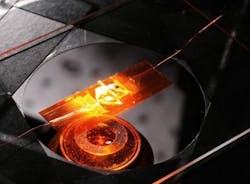Mechanically strained zinc oxide microwires boost efficiency of gallium nitride based LEDs
Atlanta, GA--As scientists from Georgia Tech and Zhejiang University (Hangzhou, China) have shown, adding zinc oxide (ZnO) microwires to gallium nitride (GaN) based UV-emitting LEDs significantly boosts the optical efficiency of the LEDs.1 The devices are the first LEDs whose performance has been enhanced by the creation of an electrical charge in a piezoelectric material using the so-called "piezo-phototronic" effect. By applying mechanical strain to the microwires the group created a piezoelectric potential in the microwires that tuned the charge transport and enhanced carrier injection in the LEDs.
"By utilizing this effect, we can enhance the external efficiency of these devices by a factor of more than four times—up to 8%," said Zhong Lin Wang, one of the researchers.
Because of the polarization of ions in the crystals of piezoelectric materials such as ZnO, mechanically compressing or otherwise straining structures made from the materials creates a piezoelectric potential. In the GaN LEDs, the researchers used the local piezoelectric potential to tune the charge transport at the p-n junction. The effect was to increase the rate at which electrons and holes recombined to generate photons, enhancing the external efficiency of the device through improved light emission and higher injection current.
The ZnO wires form the "n" component of a p-n junction, with the GaN thin film providing the "p" component. Free carriers were trapped at this interface region in a channel created by the piezoelectric charge formed by compressing the wires.
The technique boosted the LEDs' emission intensity by a factor of 17 and injection current by a factor of four when a compressive strain of 0.093% was applied to the ZnO wire. This improved conversion efficiency by as much as a factor of 4.25. The LEDs fabricated by the research team produced emissions at about 390 nm, but Wang believes the frequencies can be extended into the visible light range for a variety of optoelectronic devices.
In the experimental devices, a single ZnO micro/nanowire LED was fabricated by manipulating a wire on a trenched substrate. A magnesium-doped GaN film was grown epitaxially on a sapphire substrate by metalorganic chemical-vapor deposition, and was used to form a p-n junction with the ZnO wire.
A sapphire substrate was used as the cathode that was placed side-by-side with the GaN substrate with a well-controlled gap. The wire was placed across the gap in close contact with the GaN. Transparent polystyrene tape was used to cover the nanowire. A force was then applied to the tape by an alumina rod connected to a piezo nanopositioning stage, creating the strain in the wire.
REFERENCE:
1. Qing Yang et al., Nano Letters, 11 (9), p. 4012 (2011); DOI: 10.1021/nl202619d.

John Wallace | Senior Technical Editor (1998-2022)
John Wallace was with Laser Focus World for nearly 25 years, retiring in late June 2022. He obtained a bachelor's degree in mechanical engineering and physics at Rutgers University and a master's in optical engineering at the University of Rochester. Before becoming an editor, John worked as an engineer at RCA, Exxon, Eastman Kodak, and GCA Corporation.
